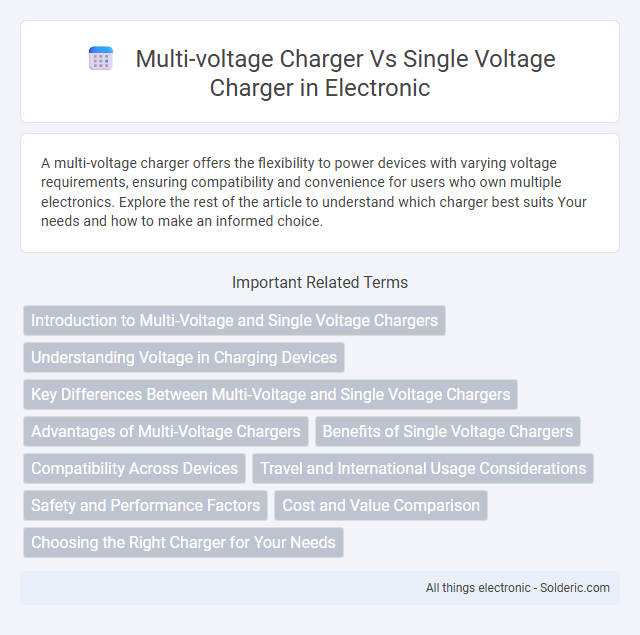A multi-voltage charger offers the flexibility to power devices with varying voltage requirements, ensuring compatibility and convenience for users who own multiple electronics. Explore the rest of the article to understand which charger best suits Your needs and how to make an informed choice.
Comparison Table
| Feature | Multi-Voltage Charger | Single Voltage Charger |
|---|---|---|
| Voltage Compatibility | Supports multiple voltage levels (e.g., 5V, 9V, 12V) | Supports only one fixed voltage level |
| Device Compatibility | Works with various devices with different power needs | Works with devices requiring a specific voltage |
| Flexibility | Highly flexible for charging multiple device types | Limited flexibility, suitable for one device type |
| Use Case | Ideal for travel and multi-device households | Best for dedicated single-device setups |
| Cost | Generally higher price due to advanced circuitry | Usually lower cost and simpler design |
| Safety Features | Includes automatic voltage detection and protection | May lack adaptive safety features |
| Energy Efficiency | Optimized for varying voltage levels, reduces energy waste | Efficient only at the designed voltage setting |
Introduction to Multi-Voltage and Single Voltage Chargers
Multi-voltage chargers support charging devices at various voltage levels, typically ranging from 5V to 20V, enabling compatibility with multiple gadgets such as smartphones, laptops, and tablets. Single voltage chargers provide a fixed output, usually designed for a specific device, ensuring optimized charging performance but limited flexibility. Your choice depends on whether you need versatility for different devices or a dedicated charger for consistent power delivery.
Understanding Voltage in Charging Devices
Multi-voltage chargers support a range of input voltages, typically 100V to 240V, enabling compatibility with different electrical systems worldwide. Single voltage chargers operate within a fixed voltage range, often designed for use in specific regions with consistent power standards. Understanding voltage in charging devices is crucial for safe and efficient power delivery, preventing damage to both the charger and the connected device.
Key Differences Between Multi-Voltage and Single Voltage Chargers
Multi-voltage chargers support a wide range of input voltages, making them compatible with electrical systems in different countries, whereas single voltage chargers are designed for a specific voltage, limiting their usability to regions with matching power standards. You benefit from multi-voltage chargers when traveling internationally or using devices in various locations without needing voltage converters. Key differences include versatility, safety features, and convenience, with multi-voltage chargers often equipped with built-in mechanisms to prevent damage from incorrect voltage input.
Advantages of Multi-Voltage Chargers
Multi-voltage chargers offer greater versatility by supporting a wide range of devices with different voltage requirements, eliminating the need for multiple chargers. They enhance convenience for travelers and professionals who carry various electronic gadgets, ensuring compatibility and reducing clutter. Your charging setup becomes more efficient and cost-effective, as a single unit adapts seamlessly to different power needs.
Benefits of Single Voltage Chargers
Single voltage chargers offer simplicity and reliability by providing a fixed, optimized output for specific devices, reducing the risk of overcharging or damaging sensitive electronics. They typically feature streamlined designs that result in lower production costs and enhanced energy efficiency, making them more economical for consumers. Their precision in voltage delivery ensures consistent performance and longer device battery life compared to multi-voltage chargers.
Compatibility Across Devices
Multi-voltage chargers offer enhanced compatibility across a wide range of devices by supporting various voltage requirements, making them ideal for users with multiple gadgets. Single voltage chargers are limited to powering devices with a specific voltage, restricting their adaptability in diverse electronic environments. Choosing a multi-voltage charger ensures seamless charging for smartphones, laptops, tablets, and other electronics without the need for multiple adapters.
Travel and International Usage Considerations
Multi-voltage chargers support input voltages from 100V to 240V, making them ideal for international travel where electrical standards vary. Single voltage chargers are limited to one voltage range, often requiring additional voltage converters or adapters for use abroad. Travelers benefit from multi-voltage chargers by reducing the need for extra equipment and ensuring device compatibility in different countries.
Safety and Performance Factors
Multi-voltage chargers offer enhanced safety by automatically adjusting to different device voltage requirements, preventing overcharging and reducing the risk of overheating or damage. Single voltage chargers may compromise performance if connected to incompatible devices, potentially causing inefficient charging and safety hazards. Your choice of charger impacts device longevity and user safety, so opt for multi-voltage solutions to ensure optimal performance and protection.
Cost and Value Comparison
Multi-voltage chargers typically cost more upfront compared to single voltage chargers due to their advanced circuitry and compatibility with multiple devices. However, their versatility can provide greater long-term value by reducing the need for multiple chargers, saving space and simplifying your charging setup. Single voltage chargers are cheaper initially but may lead to extra expenses if you require multiple chargers for different devices.
Choosing the Right Charger for Your Needs
A multi-voltage charger offers versatility by supporting a wide range of devices with varying voltage requirements, making it ideal for users with multiple gadgets or travel demands. Single voltage chargers provide optimized charging for specific devices, ensuring efficient power delivery and protection from overload. Selecting the right charger depends on your device compatibility, convenience needs, and whether you require a universal solution or a dedicated power source.
Multi-voltage charger vs single voltage charger Infographic

 solderic.com
solderic.com